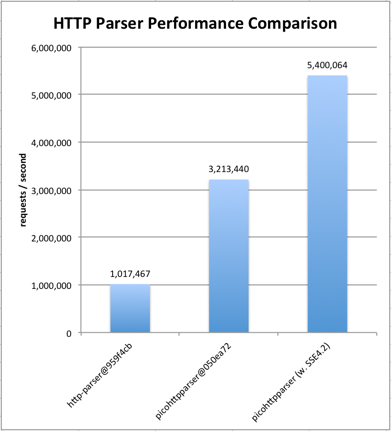PicoHTTPParser
Copyright (c) 2009-2014 Kazuho Oku, Tokuhiro Matsuno, Daisuke Murase, Shigeo Mitsunari
PicoHTTPParser is a tiny, primitive, fast HTTP request/response parser.
Unlike most parsers, it is stateless and does not allocate memory by itself. All it does is accept pointer to buffer and the output structure, and setups the pointers in the latter to point at the necessary portions of the buffer.
The code is widely deployed within Perl applications through popular modules that use it, including Plack, Starman, Starlet, Furl. It is also the HTTP/1 parser of H2O.
Check out [test.c] to find out how to use the parser.
The software is dual-licensed under the Perl License or the MIT License.
Usage
The library exposes four functions: phr_parse_request, phr_parse_response, phr_parse_headers, phr_decode_chunked.
phr_parse_request
The example below reads an HTTP request from socket sock using read(2), parses it using phr_parse_request, and prints the details.
char buf[4096], *method, *path;
int pret, minor_version;
struct phr_header headers[100];
size_t buflen = 0, prevbuflen = 0, method_len, path_len, num_headers;
ssize_t rret;
while (1) {
/* read the request */
while ((rret = read(sock, buf + buflen, sizeof(buf) - buflen)) == -1 && errno == EINTR)
;
if (rret <= 0)
return IOError;
prevbuflen = buflen;
buflen += rret;
/* parse the request */
num_headers = sizeof(headers) / sizeof(headers[0]);
pret = phr_parse_request(buf, buflen, &method, &method_len, &path, &path_len,
&minor_version, headers, &num_headers, prevbuflen);
if (pret > 0)
break; /* successfully parsed the request */
else if (pret == -1)
return ParseError;
/* request is incomplete, continue the loop */
assert(pret == -2);
if (buflen == sizeof(buf))
return RequestIsTooLongError;
}
printf("request is %d bytes long\n", pret);
printf("method is %.*s\n", (int)method_len, method);
printf("path is %.*s\n", (int)path_len, path);
printf("HTTP version is 1.%d\n", minor_version);
printf("headers:\n");
for (i = 0; i != num_headers; ++i) {
printf("%.*s: %.*s\n", (int)headers[i].name_len, headers[i].name,
(int)headers[i].value_len, headers[i].value);
}phr_parse_response, phr_parse_headers
phr_parse_response and phr_parse_headers provide similar interfaces as phr_parse_request. phr_parse_response parses an HTTP response, and phr_parse_headers parses the headers only.
phr_decode_chunked
The example below decodes incoming data in chunked-encoding. The data is decoded in-place.
struct phr_chunked_decoder decoder = {}; /* zero-clear */
char *buf = malloc(4096);
size_t size = 0, capacity = 4096, rsize;
ssize_t rret, pret;
/* set consume_trailer to 1 to discard the trailing header, or the application
* should call phr_parse_headers to parse the trailing header */
decoder.consume_trailer = 1;
do {
/* expand the buffer if necessary */
if (size == capacity) {
capacity *= 2;
buf = realloc(buf, capacity);
assert(buf != NULL);
}
/* read */
while ((rret = read(sock, buf + size, capacity - size)) == -1 && errno == EINTR)
;
if (rret <= 0)
return IOError;
/* decode */
rsize = rret;
pret = phr_decode_chunked(&decoder, buf + size, &rsize);
if (pret == -1)
return ParseError;
size += rsize;
} while (pret == -2);
/* successfully decoded the chunked data */
assert(pret >= 0);
printf("decoded data is at %p (%zu bytes)\n", buf, size);Benchmark
The benchmark code is from fukamachi/fast-http@6b91103.
The internals of picohttpparser has been described to some extent in my blog entry.

